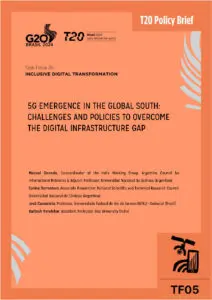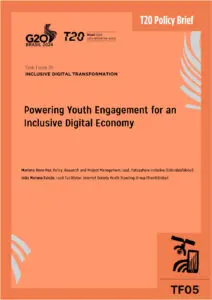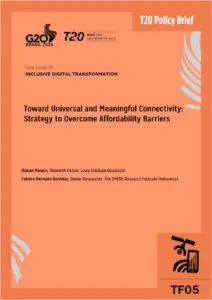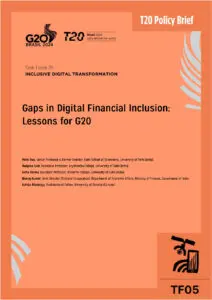The world’s population is growing old. By 2050, the portion of individuals over 65 years of age will make up approximately 16 percent of the global population. The labour market will change, while healthcare and education systems are certain to face new challenges. In parallel, digital technology will colour the global economy and people’s lives. A new perspective is required and the second demographic dividend is proposed to be the perspective of the coming era. The second demographic dividend will heavily rely on the digitally active elderly — a cohort actively involved in economic, social and personal affairs through digital technology. This calls for more attention to be given to several policy aspects, namely demand, supply and institutions.
Challenge
“The world’s population is growing older, with the age group of 65 and over growing the fastest” (World Population Prospects 2019, United Nations, 2019). By 2050, it is estimated that one in six individuals in the world will be over the age of 65 — an increase from one in 11 in 2019. By the same year, the aging population will make up around 16 percent of the global population, an increase from 9 percent in 2019. In addition, it is also important to note that population ageing is no longer isolated to developed countries but has started impacting developing countries. The projection indicates that by 2050, one in four individuals living in developed countries will be aged 65 or over, while developing countries will also have doubled their share of the population aged 65 years or over by approximately the same year.
A common factor explains this rapid growth: “the longevity revolution” consisting of economic growth, better education and better healthcare systems. However, in the future, this common factor will be seriously challenged. Methods that have worked in the past and work now will require several adjustments in the future.
Past experiences show that economic growth has been built on the shoulders of the working-age population (Ahmed and Cruz, 2018). Currently, the demographic potential support ratio is declining around the globe (WPP 2019). In Japan, the current ratio is 1.8, the lowest in the world, while in Europe and North America, as well as in East and South-East Asia, the ratio is below two. As the demographic structure continues to change, many countries will face serious issues related to the labour market, economic growth and other development outcomes over the coming decades.
In the past, the education system has been directed toward and concentrated on younger cohorts. The Education for All campaign advocated by the United Nations Educational, Scientific and Cultural Organisation (UNESCO), UN Development Programme (UNDP), UN Population Fund (UNFPA), UN Children’s Fund (UNICEF) and the World Bank through two periods of the movement, 1990-2005 and 2005-2015, did not explicitly nor openly mention the elderly population in the six education goals. Surprisingly, when the six goals were projected for the 2015-2030 Sustainable Development Goals (SDG), Goal 4, the elderly group was not boldly declared either but instead substituted with the ambiguous term “adult group”.
The healthcare system is struggling to invent methods and instruments to address geriatric-related and infectious diseases, while millions of elderly individuals have neither the access nor capability to cope with these diseases. New types of pandemics are likely to appear involving unprecedented forms of emergence and infections, while the elderly are likely to be the most vulnerable cohort. Health-related social policies and technological progress have a strong potential to deal with such diseases. However, learning from the COVID-19 pandemic, Van Jaarsveld (2020) indicated that the elderly population has not only been the worst affected by both the virus and lockdown measures, but has also received the least benefits from the digital solutions applied.
In light of the new challenges, a new perspective with an optimistic outlook is desperately required and existing potentials must be analysed further. Our proposal addresses this new perspective and its implied derivative: The Second Demographic Dividend (SDD) and Active Digital Elderly (ADE).
Proposal
The current brief recommends a new development perspective in order to address the new demographic challenges of the upcoming era, otherwise known as the “SDD”.
The SDD (Chai, 2020; Ogawa et al., 2021) views economic growth and general wellbeing as relying also upon the elderly as a productive cohort. The fundamental idea is to maximise all potentials of the elderly population, increase their capabilities and expand the choices that the elderly have. The implications are clear: Contributing to the realisation of inclusive growth, while at the same time strengthening social protections to minimise intergenerational inequality, and developing enabling environments to promote an active ageing society. This shifts the view onto the elderly, from treating the cohort as a social burden to capacitating the segment of the population towards becoming a productive cohort through participation in the development process. Under the SDD, the participation of the elderly population in the development process would significantly increase the contribution elasticity of the cohort in terms of development outcomes.
The defining characteristic of the SDD is a generation of digital ecosystems to support elderly life through income stabilisation, education, social protection and health care to help the elderly population to (re-) participate in the development process as an ADE. As the Organisation of Economic Cooperation and Development (OECD) and Global Coalition on Ageing (GCOA) Expert Consultation (2015, p. 3) states, the digital ecosystem will keep “the world’s ageing populations independent, active and working longer than previously possible”.
The support for ADE stems from three angles: the supply, demand and institutional sides. A set of technical policies in the fields of income stabilisation, education, social protection and health care must be prepared — considering that in the absence of adequate technical policies, population ageing may adversely affect development outcomes.
Digital technology, followed by artificial intelligence (AI) and internet development, represents a current and future trend. The use of information technology (IT) is not only unavoidable but also characterises the SDD. It can even be said that the era of the SDD is nothing but the era of the digital elderly. Along with an increase in digital dependency, the elderly population must be brought up to date to actively engage in economic, social and personal affairs through the digital world. Under this mechanism, ADE have the potential to solve one of the issues of the digital divide: age-based or intergenerational digital inequality (Jun, 2021). As widely recognised, the digital divide has continued to colour the current era and is commonly seen as a capability gap among individuals or social groups in accessing digital technology, along with the existence of barriers related to geography, social class, gender, ethnicity and age (Brunn and Kehrein, 2020; van Dijk, 2020).
Supply side
From the supply side, the digital elderly deal with the presence of digital infrastructure, products and services suitable for the elderly. In Van Dijk’s (2020) words, this is an issue of the “creation and distribution of digital technology”, with “availability” at the heart of the issue. Many countries continue to suffer from a lack of digital technology infrastructure, with digital products and services scarcely offered by both the public and commercial sectors. The digital elderly environment” is a proposed supply-side policy offering digital infrastructure, products and services to support the lives of elderly individuals in terms of productive finances, health and education. A digital elderly environment is marked by the production and provision of digital technology hardware and software targeted at the elderly in accessible places by using modern IT, including the internet of things (IoT), cloud computing, big data and AI, to meet the customised and personalised characteristics and attributes of the elderly.
Elderly data. For particular elderly care services, especially those provided by the public sector, data on the elderly population is inevitably desired. Though the size and share of the elderly population is increasing, the cohort remains a particular fraction — not the entirety — of the total population. Therefore, policies directed at this specific cohort must focus on the characteristics of their target population. Policies directed at the elderly must be unique and cannot be applied to other groups with different characteristics and attributes. The implications of this are clear: Such targeted policies require detailed data on elderly populations. Several countries have extensive and reliable population data collection and storage systems by name, address and several additional details on elderly characteristics and attributes. However, others require strong initiatives to develop similar data systems. Undoubtedly, the data is beneficial to various development programmes targeted at elderly populations; for example, social protection programmes.
With differences in the nature of storage systems, purposes and collection, data on elderly populations is also required from the private commercial sector. Based on the data gathered and stored, digital products and services will be supplied in easy-to-use, personalised and customised ways to the elderly. The upcoming era of digital-based businesses will also allow the business sector to be managed remotely, causing traditional mobility to be adjusted from physical to virtual (P2V) arrangements. This development will open up a number of opportunities for elderly individuals to reparticipate in the labour market and to produce ordinary, as well as elderly-specific, commercial products and services. What the private sector needs, therefore, and as per our proposal, is a business climate and environmental institutions, i.e., conditions for profit generation and job creation that enable the private sector to invest and innovate to a greater extent in elderly-customised products and services — pharmaceuticals, housing and assistive devices, homecare and educational apps.
Digital education for the elderly. Both the public and private sectors will be challenged to pay special attention to digital education for the elderly. Education in the coming digital era will be unique and wide-reaching, accompanied by the creation of new types of jobs accessible to the elderly. The uniqueness of this education stems from the structure, content, delivery and learning processes, while the wide reach refers to the kinds of and variation in skills offered to the elderly. In the near future, if the structure and characteristics of the labour market are not adaptive, the market will be marked by a “labour deficit”, in that the number of individuals leaving the labour market will be greater than those entering it, along with changes in the demographic structure.
The current policy brief proposes the creation of smart education technology infrastructure by both the public and private sectors to assist elderly individuals to swiftly return to and actively participate in the labour market and to explore all possible potentials of the elderly, thereby also addressing elderly digital illiteracy. The corresponding learning content and instruments must be constructed as tailor-made arrangements or products designed in a way that precisely meet elderly individuals’ needs. Education technology for the elderly has the potential to attract elderly individuals to respond to the supply side and, thus, to reactive in the labour market. Considering that currently and in the near future, remote work is projected to become a standard trend of the digital era, there will be plenty of room for education technology creators to provide content and instruments that fit the new work style.
Social protection for the elderly. Social protections that ensure accessibility to health care will be progressively imperative for countries with ageing populations in the coming decades. Several countries currently have low levels of investment in social protection for the elderly. Furthermore, due to the extent of informal employment and the fact that pensions are limited to a certain number of people, a significant number of individuals will continue to have no access to income security in their old age. As the portion of the ageing population becomes increasingly larger and dominates the demographic structure, investment in social protection for the elderly is crucial. Over the coming decades, the public sector will be required to broaden and deepen its basic social protection coverage for the elderly group. Generating digital systems on elderly population data will make social protection programmes more effective and efficient. Due to changes in technology, our proposal refers to a smart old-age care system based on public welfare with two main objectives: First, the digitalisation of social protection, including the use of a single ID number for all services, simple and smart e-apps, and so on; and second, the expansion of basic social protection coverage, including elderly-oriented health care and income security for the elderly.
Demand side
From the demand side, it is important to note that the coming generation of elderly people will not be a completely IT-blind generation. Several types of knowledge and skills are already at the hands of the elderly, and these knowledge and skills are a strong foundation for the elderly population in facing the new era.
AI-guided behavioural adjustments. Some behavioural adjustments are still required, considering that the speed of technological change will be dynamically high and will impact the psychological comfort zone of elderly individuals who use existing (“old”) technologies. Psychological barriers related to switching and updating to new technologies, along with the subjective preference to stay with existing (“old”) technologies, may be two of the issues faced. In the AI-based technology era, which takes into account user experiences and user preferences, such issues will no longer be significant. In the AI-based technology era, user experience and user preference will inform the technology in order to self-learn the data. As interactions between the demand and supply sides have already met the industry standards, the supply side cannot be separated from the demand side, while the demand side is also inseparable from the supply side. User experience and user preference are important forms of information from the demand side to be captured by the supply side. Meanwhile, the demand side adopts and adapts to what is available from the supply side.
Education for labour market reentry. It is now important to consider how to empower elderly individuals via skill improvement to be active digital technology users. “Active digital aging”, as a policy recommendation of this brief, continues to adapt to demand and to new technological progress. Education is unquestionably the key. However, this aspect cannot be approached through old-style learning processes. Education of the elderly in the future will represent a re- and up-skilling system, thus avoiding a potential slowdown or reversal of the Flynn effect on the growth of the intellectual quotient (IQ) of the elderly. Continuous skill improvement in a healthy work environment is indispensable to keep elderly individuals in work. ADE will become “active digital nomad” workers, bringing them back into the labour market. Therefore, ADE will realise an inclusive digital economy that requires public and private incentives for life-long re- and up-skilling through the use and modification of learning educational platforms that magnifies access to new knowledge and skills.
Institutional side
From the institutional side, as the SDD will not occur automatically, the goal of nurturing ADE can be realised if policymakers are forward-looking and respond effectively to demographic changes. In other words, the relationships between the SDD, ADE and wealth are extremely policy dependent. Maestas et. al (2016, p.3) stated that “a 10 percent increase in the fraction of the population aged over 60 decreases the growth rate of [gross domestic product] GDP per capita by 5.5 percent.” Clearly, a set of policies directed towards improving the productivity of the elderly should be a serious priority on the agenda.
Policies in the realm of productivity improvement must consider interactions between the elderly and their families, society, the commercial market and the public sector. In social protection and health-related policies, elderly care must be seen not only as part of the private-family and social responsibility domains, but also as a public sector commitment and obligation. In several countries, elderly care policies have been introduced as compulsory universal long-term care insurance policies combining contributory and non-contributory mechanisms. The policies ensure public and private funds to deliver elderly care services to their older citizens. Several other countries have introduced cash allowances, tax relief and other material incentives via private home-based elderly care subsidies and elderly parent-adult child co-residence support (Pong, 2018). At the same time, by widening the definition of elderly care, it is also evident that the commercial market participates in elderly care, where both digital and non-digital products and services are provided at accessible prices and quantities to achieve healthier ageing.
In the labour market, reforms that create incentives for older workers to reparticipate are also required for the sake of productivity improvement. The elderly suffer under the stigma that older workers are “slow” not only in terms of training but also in mastering new technologies. Thus, productivity improvement is costly — if not impossible. However, as labour productivity can be enhanced through modernising the production process, policies that attract labour markets to utilise new technologies must be formulated. Digital technologies make it possible to cut costs, making it crucial for elderly populations to master these technologies.
References
Ahmed, S. Amer and Marcio Cruz. 2018. “On the Impact of Demographic Change on Economic Growth and Poverty.” World Development 105: 95-106.
Brunn, Stanley D. and Roland Kehrein. 2020. Handbook of the Changing World Language Map. Springers.
Jun, Woochun. 2021. “A Study on Cause Analysis of Digital Divide among Older People in Korea.” International Journal of Environmental Research and Public Health 18(16): 2-13.
Maestas, Nicole, Kathleen J. Mullen, and David Powell. 2016. The Effect of Population Aging on Economic Growth, the Labour Force and Productivity. RAND Labour & Population Working Paper 1063-1.
OECD and Global Coalition on Aging. 2015. Promoting Active Ageing in the Digital Economy: Inclusion, Adaptation and Innovation (1-2 September), documented in https://www.oecd.org/sti/ieconomy/OECD_GCOA%20Report%202015.pdf (accessed 6 April 2022).
Ogawa, Naohiro, Norma Mansor, Sang-Hyop Lee, Michael R.M. Abrigo, and Tahir Aris. 2021. “Population Aging and the Three Demographic Dividends in Asia.” Asian Development Review 38(1): 32–67.
Peng, Ito. 2018. “Culture, institution and diverse approaches to care and care work in East Asia.” Current Sociology Monograph 66(4): 643–659.
Samorodov, Alexander. 1999. Ageing and Labour Markets for Older Workers. ILO Employment and Training Papers 33.
van Dijk, Jan A.G.M. 2020. Closing the Digital Divide: The Role of Digital Technologies on Social Development, Well-Being of All and the Approach of the Covid-19 Pandemic. UN Desa, accessed 04 April 2022.
van Jaarsveld, Gabrielle Martins. 2020. “The Effects of COVID-19 Among the Elderly Population: A Case for Closing the Digital Divide.” Front Psychiatry 11: 577-427.









